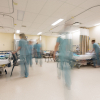- General
- Nurse Practitioners
- Registered Nurses
- Telehealth
- Career Trends
- Featured
- Legal
- News and Events
- Technology
- How To
- Procedures
- Training
- Employer News
- Candidate News
- Nursing
- Advanced Practice
Recent Posts
Most Popular
Robots Speed Up the Process for Growing Mini-Organs from Stem Cells

Scientists have developed an automated system that employs robots to create human mini-organs from stem cells.
The organs, called organoids, are rudimentary replicas that imitate the behavior of normal human organs. The organ tissues don’t have to be cut from a human but can be grown from pluripotent stem cells, cells that can produce a variety of cell types.
The production-line approach uses liquid-handling robots to introduce stem cells into plates that contain up to 384 miniature wells. Each micro-well contains 10 or more organoids.
The robots on the production line could create thousands of mini-organs in just three weeks; the same work would take human lab workers far longer to complete. Additionally, robots aren’t affected by fatigue, which often leads to mistakes. It’s widely accepted that for repetitive tasks, robots are more accurate and reliable.
The development will improve biomedical research and drug discovery by providing a more realistic organoid more quickly than people can. The use of robots prevents careless errors and accidents from ruining an elaborate experiment, as robots are widely understood to be more reliable at tedious tasks.
The University of Washington School of Medicine employed the mini-organ technique to study an illness called polycystic kidney disease, an inherited condition that affects 1 out of 600 people worldwide. The condition often leads to kidney failure.
During the study, researchers grew organoids from cells with the genetic condition, and then exposed them to a variety of substances. One of the substances, blebbistatin, produced a marked increase in the size and number of cysts associated with PKD.
For purposes of the study, the innovation allowed research teams to add more blood vessel cells to their organoids to make them more like real kidneys, and then very quickly analyze the results.
In the longer term, this capability will allow researchers to test drugs and treatments for their effectiveness on human subjects. In the past, many treatments that looked promising in animals didn’t perform as well in humans.
Prior to this development, cells for biomedical research were grown as flat, two-dimensional sheets which were overly simplistic. Researchers have successfully used adult stem cells for similar research in the past, but the pluripotent cells provide more flexibility to tweak the organoids for purposes of the study.
Pluripotent stem cells are more versatile than regular stem cells because they are capable of producing a variety of cell types. This offers huge potential for use in high-throughput screening (HTS), which is commonly used in drug discovery to accelerate and automate tests.
The key to this research is HTS’s ability to introduce, incubate, and analyze microwells rapidly and automatically. As a result, the process is more accurate and more viable, and researchers have more control over variables. To date, HTS systems are able to test about 10,000 compounds per day.
Organoids made from cortical tissue offer another great leap for medical research, but they also introduce a certain amount of controversy into the discussion. At what point, researchers ask, does a brain become large enough and complex enough to experience pain?








Comments